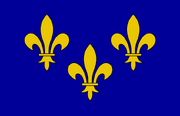
Fleur-de-lys coat of arms
The Kingdom of France (843-1792, 1814-1815, 1815-1848) was an absolute monarchy founded in the aftermath of the Frankish Empire. The Kingdom of France was situated in Western Europe, and controlled the former territories of "West Francia", which was conquered by the Franks in the Late Roman Empire. Francia became "France" around the 11th Century, during Philip Augustus reign, who permanently replaced the title of "King of Franks".
It became the hegemonic power of Europe following the end of the Hundred Years' War in 1453, and began building a colonial empire in 1534 onwards. France expanded from its home to include Canada in North America, some ports in India and Africa, and some other parts of Europe. In almost its entire history, France fought the Kingdom of England over dominance in Europe and the New World. Despite its victory in the Hundred Years War, the kingdom was eventually surpassed by England in the 17th and 18th Centuries, which were characterized for an almost non-stop state of war. Internal crisis and revolutionary movements lead to the French Revolution in 1789, which established the French Constitutional Monarchy in 1791. The monarchy was abolished one year later, and the First French Republic was proclaimed.
History[]
Early History[]
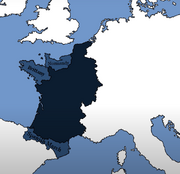
France in 943. The kingdom would gradually expand in the following centuries.
Founded in 843 after the division of Charlemagne's Frankish Empire, the Kingdom of Western Francia was originally ruled by a son of Charlemagne who was given control of the western third of the empire. The central third evolved into Burgundy and the eastern half turned into the Holy Roman Empire/Austria (so-called because of the German word for "Eastern Empire", "Osterreich"). France was divided between feudal barons loyal to the king, and it quickly became the norm for the new king to have to combat nobles who claimed succession.
The original line of French rulers was part of the previous Carolingian dynasty, but it was eventually replaced by the House of Capet, founded by Hugh Capet in 987. France's Capetian rulers controlled most of present-day France's borders, but failed to include the lands of Bretagne, ruled by the Duchy of Brittany; they also missed on Metz and Dijon, controlled by the Burgundians; Bordeaux, ruled by the Duchy of Aquitaine; and Normandy, controlled by the Duchy of Normandy, which was founded by Vikings given a fief in France by King Charles the Simple. The descendents of Hugh Capet would continue to rule France for almost nine hundred years, until the definitive end of the monarchy in 1848.
Medieval Era[]
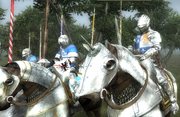
French knights
In the early Medieval Era (1000-1500), France could boast the most powerful cavalry in Europe, and they used it to combat the enemies on their borders. King Philip I of France conquered all of France for the French in the 1080s, apart from Normandy (which belonged to the Kingdom of England since 1066), and he also took control of most of Flanders from the Flemish nobles. However, he soon fell into conflict with the Holy Roman Empire, who competed for land, and made enemies in the Middle East when he led a crusade to capture the Holy Lands from the Seljuk Empire and Fatimid Caliphate. France tried to expand and defend its borders for the rest of the Middle Ages, often taking part in crusades against the Middle East. They not only fought for Catholicism in the Levant, but fought against incursions by the English. From the 1200s onwards they combatted English control over southern and central France, and in the 1300s-1400s they liberated France from English rule.
In 1328, a succession crisis struck the French monarchy. Charles IV of France died without an heir, the nearest male relative was his nephew Edward III of England, but Charles's paternal cousin Philip VI of France was elected king. The dispute resulted in the beginning of the Hundred Years' War in 1337. The English won the earliest stages of the war, but they were eventually defeated in 1453 and had to leave many of their french possessions. A former peace treaty was signed in 1475, but the English monarchs would continue to claim the French throne until the 1803.
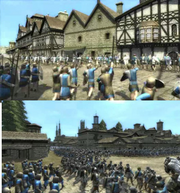
French expedition in 1550 to Florida
Having defeated numerous invaders, France played the role of villain when they began to invade Italy in search of new lands. From 1494 to 1558 they failed to stake claims to Italy, hoping to revive Angevin claims to Italy that were laid down by Charles of Anjou after the Battle of Benevento in 1266. Despite their losses in Italy, they established colonies in the Americas, inducting Canada into their empire. France was later torn apart again in the French Wars of Religion, in which the Catholic government fought the Huguenot noblemen of the country. The Huguenots eventually gained rights in the 1598 Edict of Nantes, but although France had given Protestants rights, the Germans refused, causing a revolt that would pit Protestants and Catholics from all over Europe to fight: the Thirty Years' War.
Early Modern Era[]
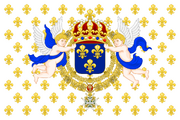
Flag of Bourbon France
From 1618 to 1648 the Imperial army and Northern European Protestants fought; France was Catholic, but they were opposed to the House of Habsburg, which controlled the Holy Roman Empire and the Spanish Empire, so they made war as an ally of the Protestants. Although the war ended in 1648, warfare between France and Spain continued until 1658. The French defeated a Spanish invasion at the Battle of the Dunes, and from 1667 to 1697, King Louis XIV of France fought Spain and the other powers of Europe in a series of wars in the Low Countries.

In 1700 a fresh round of fighting was triggered in the War of the Spanish Succession, when France tried to place the Duke of Anjou on the Spanish throne after Carlos II of Spain's death. Spain and France allied against those who would oppose Angevin sovereignty over Spain, namely Great Britain, the Austrian Empire, the Kingdom of Prussia, the United Provinces, the Duchy of Brunswick-Luneburg, and Habsburg Spanish loyalists. In 1714 the war ended with a French victory, as the Duke of Anjou became Felipe V of Spain. In the aftermath of the war, France proved to be a major military power in modern Europe.
France devoted the years of 1714-1740 in military reform, testing their army once more in the War of the Austrian Succession in the 1740s. At the Battle of Fontenoy in 1745, they defeated the British, Dutch, and Austrians in a large battle masterminded by Maurice de Saxe. De Saxe reformed the French army, issuing lambskin wigs to all soldiers and uniforming and equipping a massive army. By the end of the war in 1748, France had again won a major war fought not only in Europe, but also in the Americas and India.
Colonial Era[]
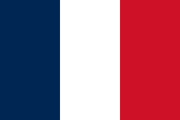
Flag of the French rebels
In 1750 France was on the defensive again, constructing a string of forts down the Ohio Valley to draw a border line that connected Canada to Louisiana. Offensive to the British, this string of forts was marked for destruction, resulting in the French and Indian War. The British attacked these forts in 1755 unsuccessfully, and the French counterattacked with Indian aid, destroying Fort Oswego and slaughtering the garrison of Fort William Henry. But in 1759 the British made a counteroffensive and captured Quebec and in 1760 took Montreal, and the French were defeated.
By then, war had already broken out in Europe in the Seven Years' War in 1756, with France and the Austrian Empire forming a defensive alliance, which the Prussians saw as a threat. The Prussians invaded Saxony and also fought against the French, and France was heavily defeated at the Battle of Rossbach in 1757. By 1763, when the Treaty of Paris ended both conflicts (which were related due to the Anglo-French War in Europe), France had lost all of North America to Britain and ceded Louisiana to Spain, maintaining only a few Caribbean islands and French Guyana.
A new opportunity of reconquest came in 1778, when they allied with the fledgling United States and pushed the British out of the Thirteen Colonies, giving the USA independence and giving France more territory in the Americas. But a down-side to the American Revolution came: France's Third Estate peasants felt that they should also overthrow a tyrant, the reigning Louis XVI of France. In a revolution led by the bourgeoisie (middle class), the peasants overthrew the Second Estate nobles and First Estate clergy in 1789 and created a constitutional monarchy, limiting the power of the French king. But in 1792, when Louis XVI asked for intervention to restore him to the throne, the French people executed all monarchists and ended the monarchy, creating the First French Republic.
Gallery[]
Italian Wars 1.png|French cavalry fighting the Papal States French knights.png|French general and knights French colonists.png|French colonists French fort.png|French troops in the Ohio Valley French army 1700s.png|French troops French pikemen.png|French pikemen Swiss troops.png|Swiss troops National Guard 2.png|National Guard troops
| Kingdom of France | ||
|---|---|---|
| Preceded by: |
843 – 1791 | Succeeded by: |
